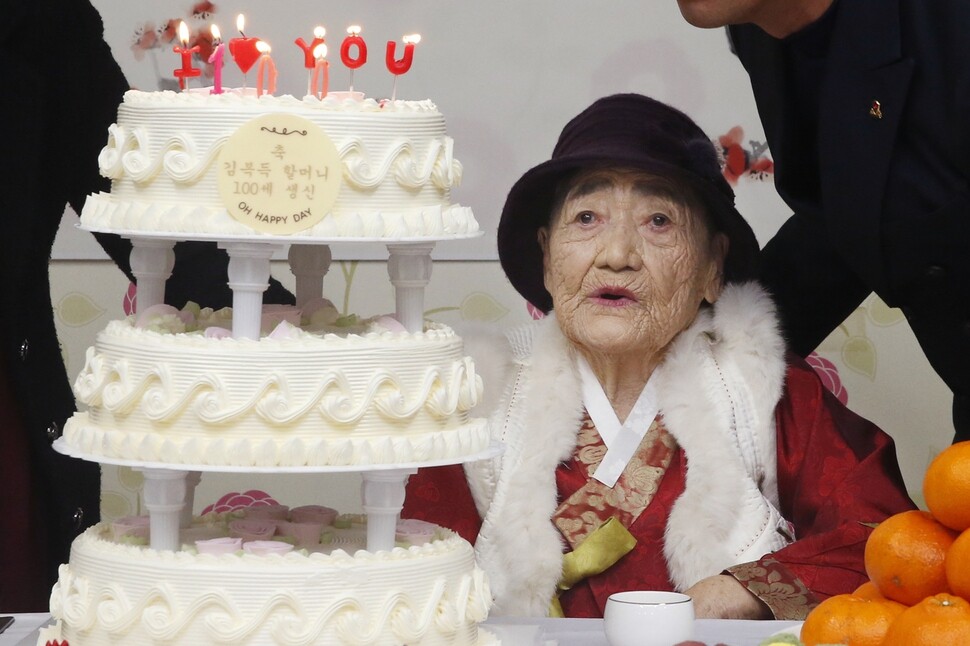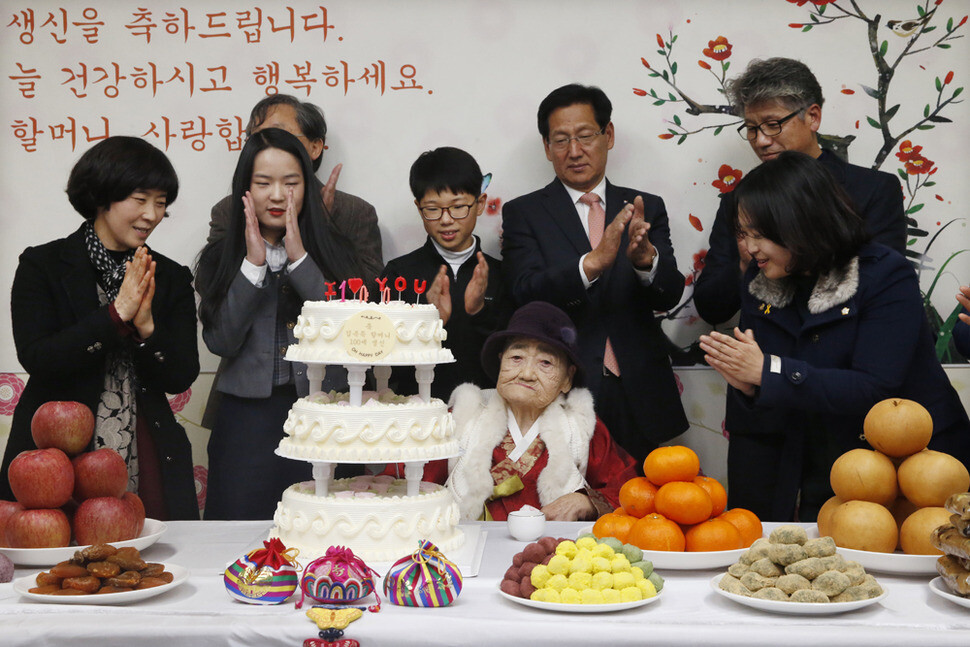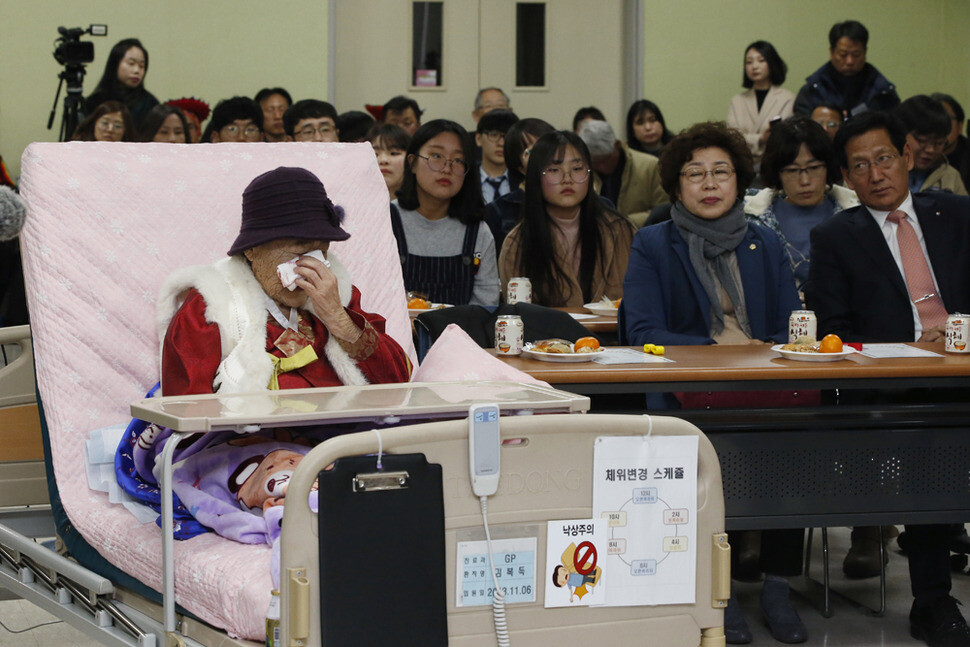hankyoreh
Links to other country sites 다른 나라 사이트 링크
On her 100th birthday, former comfort woman can only say “Thank you for your help”

“Thank you. Thank you so much for your help,” said Kim Bok-deuk, lying in her sickbed and struggling with each breath, in response to Song Do-ja when Song asked her toward the end of her 100th birthday party to say a word to all the well-wishers at the party. Song, the head of the Tongyeong and Geoje Civic Group That Stands With the Comfort Women, had organized the party.
Next, Song asked Kim what her wish was this year, but Kim didn’t say a thing. Tears slid down the deep wrinkles on her cheeks.
A total of 239 women reported to the South Korean government that they had been taken to serve as comfort women for the Japanese army during Japan’s colonial occupation of Korea. As of Jan. 15, 199 of those women had already breathed their last without receiving an apology from Japan, and just 40 remained alive. Kim is the second oldest of the surviving comfort women (after Jung Bok-su, 102). Kim was born on Jan. 14, 1918, or Dec. 17 according to the lunar calendar, and turned 100 years old (Korean age) on Jan. 14.
Kim’s 100th birthday party on this day was held at the assembly hall of the Tongyeong Sanitorium Hospital in the city of Tongyeong in South Gyeongsang Province. Kim moved into the hospital on Nov. 6, 2013, because of her struggle with Alzheimer’s disease.
“If I get an apology from Japan for its crimes before I die, I won’t have any other wishes. But if I did have another wish, it would be that in the next life I could wear a bridal headpiece, get married and have a happy life as other people do.”

This was something that Kim would often say until a few years ago. But now she barely recognizes a few close friends and only has brief conversations. Even at her 99th birthday party, she hardly said anything and only hinted at her feelings through facial expressions and nods of her head. Even when students from Tongyeong High School and Tongyeong Girls‘ High School put on a talent show for her, with a traditional Korean drum performance, dancing and singing, she only smiled faintly and sometimes shed some tears. She didn’t even respond when they played her favorite song, “Teacher at the Island Village.”
“She did her makeup in the morning for her birthday party. When I gave her the thumbs-up and told her she looked pretty, she just smiled broadly without saying a thing,” said Kim Eun-ae, 25, Kim Bok-deuk‘s grandniece.
“She had snailfish stew this morning. She eats anything, whether it’s abalone porridge, roasted chicken, pizza, but lately she has been particularly fond of croquettes,” Kim’s nurse said.

Kim is afraid of people wearing black, and she sometimes has seizures. “It’s probably because she‘s reliving nightmares of when the Japanese soldiers dragged her away to be a comfort woman. That’s why when groups of students visit the hospital in their school uniforms, we ask them to wear red outfits the next time they come,” Song Do-ja said.
Kim has been an active member of efforts to receive an apology from Japan since she added her name to the government‘s list of former comfort women in 1994. She testified of the things she had suffered as a comfort women during meetings held in Nagoya, Japan, in 2007 and in Osaka in 2011, and she also held a demonstration in front of Japan’s House of Representatives in 2010. Kim even donated 20 million won (US$16,950) to establish a scholarship at Tongyeong Girls’ High School in 2012 and another 20 million won for a fund to establish a history memorial for the comfort women in South Gyeongsang Province in 2013. That was her entire life’s savings.
In keeping with Kim‘s wishes, the South Gyeongsang Province Office of Education published a book called “Don’t Forget Me” in 2013 that tells Kim‘s life story and instructed all elementary, middle and high schools in the province to use it as a history textbook. The office has also published Japanese and English translations of this book and distributed them in Japan and the US. The same year, the “monument to justice,” a statue of a young woman symbolizing Kim, was installed at Nammang Mountain Park in Tongyeong.
“The very existence of Kim Bok-deuk is a symbol of human rights and the dignity of women. How offended she would be to learn that the South Korean government made an absurd agreement with the Japanese government on Dec. 28, 2015, that basically sold out the comfort women issue for 1 billion yen,” said Song.
Kim was born in Tongyeong, South Gyeongsang Province. In 1939, at the age of 22, she had gone to the wharf to visit an aunt living in Jangseungpo, Geoje, when broker who promised to find her work at a factory tricked her into following him to Busan. As the oldest child of three, one boy and two girls, Kim had believed she ought to earn money for her parents and her younger siblings.
“In the past, she hardly ever talked about what she went through during the Japanese colonial period. Until she registered herself as a former comfort woman, I had assumed she had been pressed into labor in Japan,” said Kim Chang-wook, her nephew.
But the ship that Kim boarded in Busan stopped at the Chinese city of Dalian. In the end, Kim was forced to work as a comfort woman under the name of Fumiko and to follow the Japanese forces when they relocated from China to the Philippines. Shortly after Korea was liberated from the Japanese occupation, Kim was released and returned home.
By Choi Sang-won, South Gyeongsang correspondent in Tongyeong
Please direct questions or comments to [english@hani.co.kr]

Editorial・opinion
![[Column] Season 2 of special prosecutor probe may be coming to Korea soon [Column] Season 2 of special prosecutor probe may be coming to Korea soon](https://flexible.img.hani.co.kr/flexible/normal/500/300/imgdb/original/2024/0426/3317141030699447.jpg) [Column] Season 2 of special prosecutor probe may be coming to Korea soon
[Column] Season 2 of special prosecutor probe may be coming to Korea soon![[Column] Park Geun-hye déjà vu in Yoon Suk-yeol [Column] Park Geun-hye déjà vu in Yoon Suk-yeol](https://flexible.img.hani.co.kr/flexible/normal/500/300/imgdb/original/2024/0424/651713945113788.jpg) [Column] Park Geun-hye déjà vu in Yoon Suk-yeol
[Column] Park Geun-hye déjà vu in Yoon Suk-yeol- [Editorial] New weight of N. Korea’s nuclear threats makes dialogue all the more urgent
- [Guest essay] The real reason Korea’s new right wants to dub Rhee a founding father
- [Column] ‘Choson’: Is it time we start referring to N. Korea in its own terms?
- [Editorial] Japan’s rewriting of history with Korea has gone too far
- [Column] The president’s questionable capacity for dialogue
- [Column] Are chaebol firms just pizza pies for families to divvy up as they please?
- [Column] Has Korea, too, crossed the Rubicon on China?
- [Correspondent’s column] In Japan’s alliance with US, echoes of its past alliances with UK
Most viewed articles
- 1‘We must say no’: Seoul defense chief on Korean, USFK involvement in hypothetical Taiwan crisis
- 2[Column] Season 2 of special prosecutor probe may be coming to Korea soon
- 3N. Korean delegation’s trip to Iran shows how Pyongyang is leveraging ties with Moscow
- 4Korea sees more deaths than births for 52nd consecutive month in February
- 5Amnesty notes ‘erosion’ of freedom of expression in Korea in annual human rights report
- 6[Reportage] On US campuses, student risk arrest as they call for divestment from Israel
- 7[Editorial] New weight of N. Korea’s nuclear threats makes dialogue all the more urgent
- 8‘Weddingflation’ breaks the bank for Korean couples-to-be
- 9[Column] Has Korea, too, crossed the Rubicon on China?
- 10[Column] Park Geun-hye déjà vu in Yoon Suk-yeol